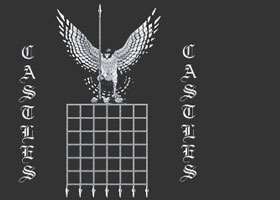| | Roman Temples - Facts and Information about Roman Temples
- The Design of the Roman Temples
- Construction of Roman Temples
- Roman Gods and Goddesses
- The wealth of the Roman Temples
- Who were the Vestal Virgins
| | | |
| | The History of Roman Temples
The Roman Temples and the history of Roman Architecture was divided into two distinctive eras. The first era was of the Roman Republic where the origins of Roman architecture can be traced to the Etruscans, who migrated from Asia Minor to Italy in the 12th Century BC. The ancient Etruscans mirrored the Greek and the Phoenician traditions building large temples to honour their Gods. The second era started in 27BC and is classed as the period of the Roman Empire. |
Roman TemplesThe Roman Temples
The Romans built temples to worship their Gods and Goddesses. Roman temples featured some, or all, of the following: - Roman Temples had a gabled roof
- A deep porch with free-standing columns
- A frontal staircase giving access to a high platform
- New materials were used in the construction of Roman Temples such as concrete with brick and stone facing and marble veneers
- Walls of Roman Temples were painted in fresco - the frieze often depicted Roman life
- Sculptures of Roman Gods and Goddesses were used as decoration in the form of free standing statues
- Many Roman Temples were commissioned by Roman Generals to thank the Gods for the generals' victories
- In Ancient Rome a fundamental basis of the religion was the belief that if the Gods were happy then they would receive good fortune. It was therefore important to worship the Roman Gods on a daily basis.
- Roman Temples were large, ornate and numerous
- Outside the Roman Temples traders sold small birds and animals which were offered to the Gods as sacrifices
- The Roman temples were located in important positions such as at one side of the forum or along a major road
- The distance between Temple columns were proportional to the diameter of the column
- Engravings of Roman Temples were featured on Roman coins
- Roman Temples were dedicated to specific Roman Gods and Goddesses
The Roman Gods and Goddesses - Romans had hundreds of different gods. Prayers were offered to relevant Gods and Goddesses - in matters of love the Romans would pray to Venus. Soldiers would pray to Mars the God of War and so on. There was a Roman God to suit all requirements
- The total collection of Roman gods was called the Pantheon
- A main group of twelve Roman Gods called the Dii Consentes were worshipped at the temples - Jupiter, Juno, Venus, Mars, Mercury, Neptune, Minerva, Vesta, Ceres, Diana, Volcan, and Apollo
- Other important Roman Gods honoured at the temples included Janus, Saturnus, Flora, Pomona, Portunus, Fontanus, Bacchus, Cupid, Hercules, Pluto and Ulysses
|
The Roman Vestal Virgins - The Vestal Virgins were the priestesses of Vesta who was the Roman goddess of the hearth fire. They had to adhere to a life of chastity during their thirty year term as vestal virgins. A Vestal Virgin who lost her virginity suffered the punishment of being buried alive
Roman Temples dedicated to the Emperors
Some Roman temples were dedicated to the Roman Emperors such as the temple which was built at Colchester in honour of the Emperor Claudius. The Decline of the Roman Temples
In 312AD the emperor Constantine the Great believed he had received a sign from the God of the Christians in a dream on the night before an important battle. The battle and the Emperor Constantine showed his gratitude by converting to Christianity. The whole of the Roman empire followed the lead of their emperor and the great Roman Temples began their decline. The Roman Temples in Britain
A Roman temple was built at Maiden Castle in England after the Romans conquered the Celtic inhabitants called the Durotriges tribe. The best known Roman Temples in England are the Aquae Sulis and Minerva temples at Bath and the Claudius temple at Colchester. The most frequent locations for temples are in the larger towns or on military sites such as forts or frontiers. Londinium!
The Romans built a fort, called Londinium, on the site of present day London on the North Bank of the River Thames at the lowest firm bridging point in 43AD. Londinium housed many Roman Temples. Londinium was not the capital - this was Colchester or, given its Roman name, Camulodunium. St Pauls Cathedral was built on the site which once housed a Roman Temple dedicated to the goddess Diana. Another Roman Temple dedicated to the God Appollo once stood at Westminster. Roman Temple of Mithras discovered in London (Londinium)
Traces of our Roman ancestors are still being discovered. In 1954 excavations North of Cannon Street led to the discovery of the Roman Temple of Mithras. This Roman Temple was built on the East bank of the Wallbrook stream which is an estuary of the River Thames - the remains can be viewed at Bucklesbury House in Victoria Street. The re-constructed temple is now on an elevated platform some six feet above street level. The remains of two square Romano-Celtic temples have also been found at a Roman temple complex in Southwark in South London. |
|
|

